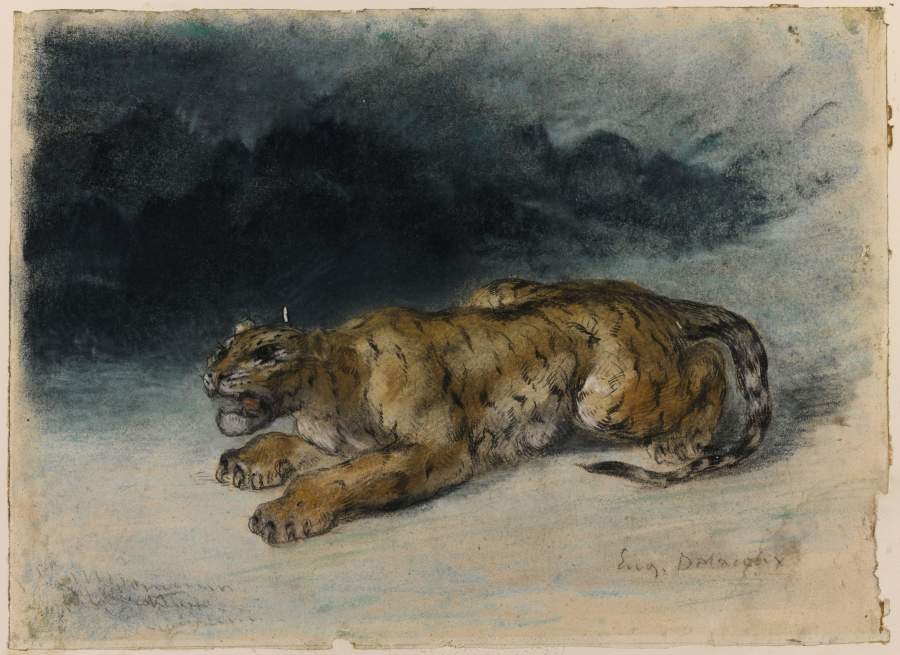23 by 31 cm.
An exceedingly rare and important Delacroix pastel with historic provenance.
Provenance
Philippe Burty (1830-1890), Paris
Hayashi Tadamasa (1853-1906), Paris (acquired
from the above)
Henry Osborne Havemeyer (1847-1907) and his wife Louisine
Waldron-Elder (1858-1929), New York (acquired from the above in 1889)
Durand-Ruel, New York and Paris (deposited by H. O.
Havemeyer in March 1895, purchased in March 1898)
Marie-Louise Durand-Ruel (1897-1991) and her husband Jean
d’Alayer de Costemore d’Arc (1897-1991) (daughter and son-in-law of Joseph
Durand-Ruel, acquired from the above in 1949 and sold, Galerie Charpentier,
Paris, June 3, 1954, lot 4, illustrated, pl. III)
Alexander M. Lewyt (1909-1988) and his wife Élisabeth Roulleau Lewyt (1913-2013), New York and Sand’s Point (acquired from the above, April 1960)
Private Collector (bequeathed by Élisabeth Rolleau Lewyt, 2013)
Exhibited
Philadelphia Museum of Art, Romanticists and Realists, 1934 (lent by Durand-Ruel, exhibition was without published catalogue, museum then known as the Pennsylvania Museum of Art)Paris, Jean Claude and Jacques Bellier (Sociétè d’Expansion Artistique), D’Ingres à nos jours: aquarelles, pastels et dessins, 1960, no. 19 (listed as being in the collections of “Havemeyer-Burty-Ayashi”)
Literature
Raymonde Wilhélem, “Les Grandes Ventes,” Plaisir de France, no. 220, February
1957, p. 59, illustrated
Eve Twose Kliman, “Delacroix’s Lions and Tigers: A Link Between Man and
Nature,” The Art Bulletin,
vol. 64, no. 3, 1982, p. 461, illustrated. p. 462, fig. 33 (location of
pastel mistakenly given as the Cleveland Museum of Art)
Gretchen Wold, “Checklist of European and American
paintings, watercolors, and drawings collection by Mr. and Mrs. H.O.
Havemeyer,” Splendid Legacy: The Havemeyer
Collection, New York, 1993, p. 339, no. 263
Lee Johnson, The Paintings of Eugène
Delacroix: A Critical Catalogue,
Oxford, 1993, vol. III, p. 32, cited under no. 209 (author repeats E.T.
Kliman’s incorrect location of the pastel as the Cleveland Museum of Art)
Lee Johnson, Delacroix
Pastels, New York, 1995, pp. 120-1, illustrated (author repeats E.T.
Kliman’s incorrect location of the pastel as the Cleveland Museum of Art)
Delacroix: les dernières années,
exh. cat., Galeries nationales du Grand Palais, Paris; Philadelphia Museum
of Art, 1998, p. 317, cited under entry no. 132 (entry by Vincent Pomarède
and repeating E.T. Kliman’s incorrect
location of the pastel as the Cleveland Museum of Art)
Catalogue note
As one of the keepers of Delacroix’s legacy, and the editor of the Letters of Delacroix published in 1878, Philippe Burty, emerged as one of the most dedicated collectors of contemporary art including prints as well as Japanese art in all media.[1] He was the first owner of this pastel.[2] Since Burty had an intimate knowledge of the way in which Delacroix worked, had access to unpublished material, and was able to discuss Delacroix’s approach to creativity with the artist and some of his students, this pastel has an impeccable provenance allowing the work to emerge as a rare example of the French romantic artist’s work which remains outside of museum collections.
Since considerable interest is now focused on Delacroix’s work through new books and exhibitions, he is seen as the primary example among artists of his generation in the use of brilliant evocative color in painting , watercolors and drawings. Recognized now as a precursor in the evolution of the modern movement, this pastel, with its loose energetic application of the medium, provides a significant clue as to why Delacroix is held in such high regard by collectors. His sense of independence and personal power are hallmarks of his style.[3]
The romantics also placed considerable emphasis on animals in their works as horses, lions and tigers are often depicted; the primary example in sculpture being Antoine-Louis Bayre. These animals symbolized the dynamic power of the Romantic Movement and its abiding interest in exotic material that dominated much of the tradition. This pastel is no exception. The vigor of the execution, the sense of urgency that the tiger conveys, provides a way in which the image mesmerized the original collector while also becoming part of a series of impressive collections in the United States. The pastel is a rare object, which any collector of nineteenth century art would be proud of owning.
Gabriel P. Weisberg, University of Minnesota
[1] . Eugène Delacroix “Ceci est mon testament:” in Philippe Burty, Lettres de Eugène Delacroix publiées par M. Philippe Burty, Paris: A. Quantin, 1878, p. VII where Delacroix states that “Je prie MM. Perignon, Dauzats, Carrier, baron Schwiter, Andrieu, Dutilleux et Burty, de s’entendre avec mon légataire universel et de classer mes dessins.”
[2] . Gabriel P. Weisberg, The Independent Critic. Philippe Burty and the Visual Arts of Mid-Nineteenth Century Art, New York: Peter Lang, 1993.

